|

Can you find a hunting serval (Felis serval hindei) in this picture? It is sharing a small savanna swamp
with African elephants (Loxodonta africana), African buffalos (Syncerus caffer), grey-necked crowned
cranes (Balearica regulorum), sacred ibises (Threskiornis aethiopicus), cattle egrets (Bubulcus ibis),
and countless other creatures. Mt. Kilimanjaro is visible in the background. Amboseli Nat'l Park, Kenya.
Wild Cats - Part 4
|
| Other African cats are much more difficult to see, except for cheetahs (Acinonyx jubatus). Cheetahs are not particularly numerous in East Africa, where lions and hyenas often steal most of their kills. But they prefer open plains and are mostly diurnal, so if you can afford a few days in National parks of Kenya or Tanzania, you should be able to find at least one. |
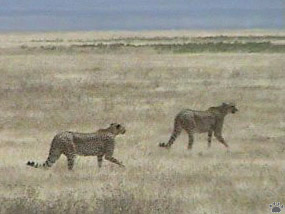
Two brothers on a hunt, Masai Mara Nature Reserve, Kenya. |
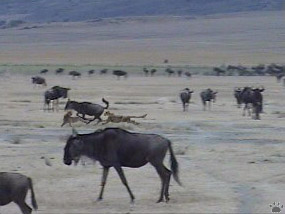
Cheetahs catching a wildebeest, Masai Mara. |
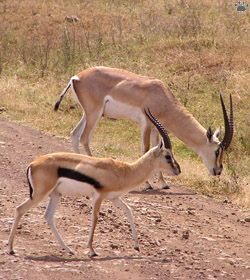
Grant's (Gazella granti) and Thomson's (G. thomsoni)
gazelles, Ngorongoro Crater, Tanzania. |
The favorite prey of cheetahs is small antelopes, especially gazelles, but when hunting in pair, they go for a wildebeest or a young zebra. |
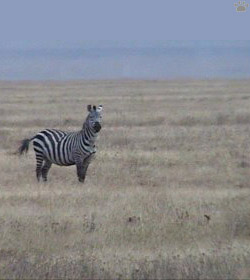
A zebra nervously watches a cheetah hidden in the grass.
Ngorongoro.
|
 |
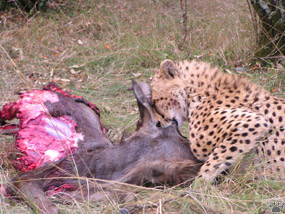 |
| Cheetahs eating a wildebeest, Masai Mara. |
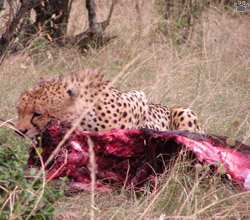
Cheetah at work, Masai Mara. |
It took these two cheetahs just over seven hours of hard work to kill and consume a half-grown wildebeest. |
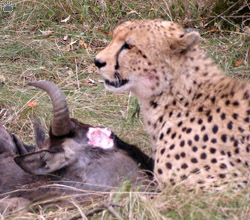
Cheetah at work, Masai Mara. |
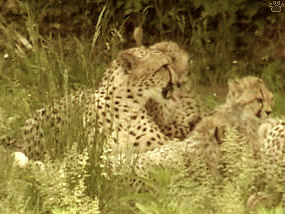
Cheetah with cubs, Hell's Gate National Park, Kenya. |
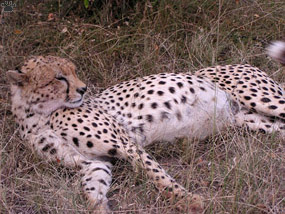
Cheetah resting after a seven-hour meal, Masai Mara. |
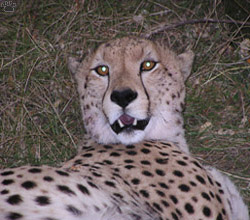
Cheetah, Masai Mara. |
Wild cheetahs can be very tame, especially after a good meal. These two even allowed me to pet them. |

Cheetah at work, Masai Mara. |

Ngorongoro Crater, Tanzania, would be the world's best place to see wild cats if you could shoot all 10,000 other tourists and walk around at night. |
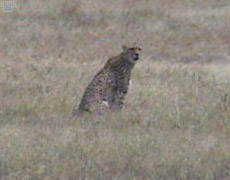
Lone cheetah, Ngorongoro. |
More often, cheetahs hunt alone. In addition to antelopes, they regularly catch hares (Lepus), springhares (Pedetes capensis) and sometimes birds. |
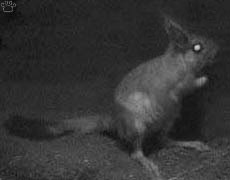
Springhare, Hell's Gate Nat'l Park, Kenya. |
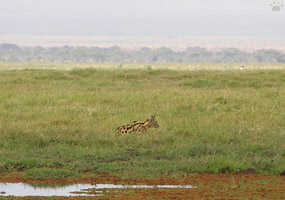
Swamps of Amboseli National Park, Kenya, are a good place to
look for servals in the morning or before sunset. |

Unstriped savanna mice (Arvicanthis) are a favorite prey of servals
in drier habitats. Serengeti National Park, Tanzania. |
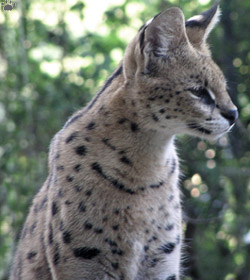
Serval, Mount Elgon National Park, Kenya. Mountain servals
are usually grayish rather than bright yellow. |
Serval is another partly diurnal cat of open grassland. It prefers tallgrass meadows and swamps, often in the mountains, where rare black form occurs. |

This is probably the first photo of black serval in the wild.
Aberdare National Park, Kenya. |
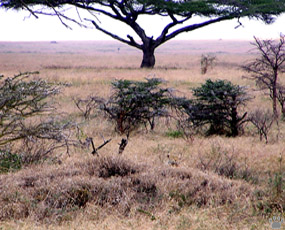 |
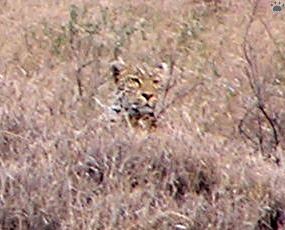 |
| East African leopards (Panthera pardus leopardus) are masters of camouphlage. This one is hidden in plain view on a small hill. Serengeti. |
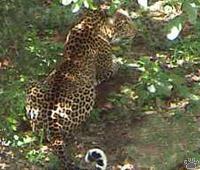
Leopard, Uzambara Mountains Nature Reserve,
Tanzania. |
Leopards are common in wooded habitats throughout East Africa, including high mountains, but they are shy and difficult to see. In savanna National parks, they prefer riparian forests, where they can drag their kills up tall acacia trees to avoid lions and hyenas. |
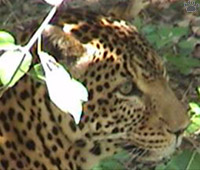
Leopard, Uzambara Mountains,
Tanzania. |
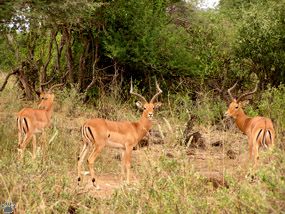 |
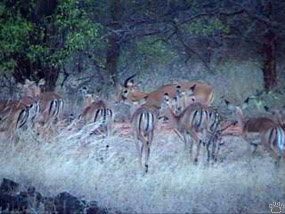 |
| Although leopards hunt everything from mice to gorillas, impalas (Aepyceros melampus) are their favorite prey in many areas. Impalas prefer edges of savanna woodlands, and occur either in male-only groops (left) or in harems guarded by a single male (right). Lions and cheetahs also hunt them. |

African wild cat can be difficult to distinguish
from domestic cat, with which it often interbreeds.
Tsavo West Nat'l Park, Kenya. |
East African wild cat (Felis lybica brockmani) is the most numerous wild feline of Kenya and Tanzania, but seeing it requires a lot of night hiking. As most other small cats, it is very shy and fast, so it is seldom seen on night drives. Sometimes you can spot it at dusk. In many areas it is threatened by hybridyzing with feral cats. |
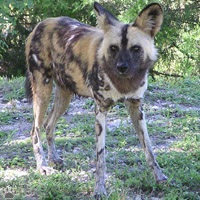
Wild dogs (Lycaon pictus) used to be the major
competitors of wild cats in the savanna. Now they
are extinct or very rare in most areas. Aberdare. |
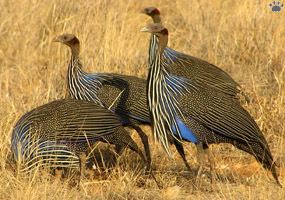
Vulturine (Acryllia vulturinum) and other guineafowl are a popuar prey
among African predators. Servals, caracals, cheetahs, leopards, golden
and
African wild cats, even lions hunt them. Samburu Nat. Res., Kenya. |
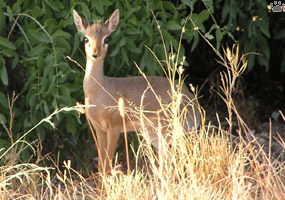
Dikdiks (Madoqua) are so vary, they look almost paranoid. But
servals and caracals hunt them regulrly. This is a rare silver dikdik
(M. piacentinii) from Kisimayo area, Somalia. |
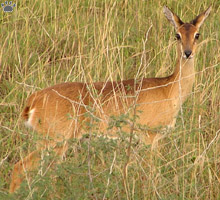
Oribi (Ourebia ourebi) replaces gazelles in wetter
savannas. Murchison Falls Nat'l Park, Uganda. |
There are two cat species in Africa I haven't seen yet: tiny black-footed cat (F. nigripes) of southern deserts, and beautiful golden cat (F. aurata) of western forests. I hope to find them next time I get there. |
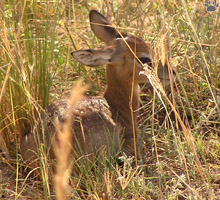
This baby oribi was hiding in the grass within ten
meters from a resting pride of lions. Murchison Falls. |

Cheetahs purr when petted. Masai Mara.
Part Five
Back to Part Three
Home
|

